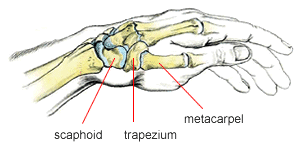Hand Joints
The thumb has three joints, not only two, of which the first, the articulation with one of the bones of the middle hand
(trapezium [1] or greater multi-angular[2] , so called from its size and shape) is the most important .
This joint , located close to the wrist, differs radically from the equivalent joints of the other fingers.
About an approximately transverse[3] axis flexion and extension take place, as in lifting and dropping the thumb in the simple thumb-stroke on the piano; around an antero-posterior axis abduction and adduction occur, illustrated by the passing-under of the .thumb in the scale and the arpeggio. Movements combining these axes result in considerable circular movement (circumduction), and, finally, a slight rotation around the longitudinal axis of the thumb is also possible. It is this first joint , technically called carpo-metacarpal joint, that is chiefly involved in the thumb movements of piano technique. The joint is near the wrist and its articulation may be seen by touching the base of the little finger with the tip of the thumb of the same hand.
About an approximately transverse[3] axis flexion and extension take place, as in lifting and dropping the thumb in the simple thumb-stroke on the piano; around an antero-posterior axis abduction and adduction occur, illustrated by the passing-under of the .thumb in the scale and the arpeggio. Movements combining these axes result in considerable circular movement (circumduction), and, finally, a slight rotation around the longitudinal axis of the thumb is also possible. It is this first joint , technically called carpo-metacarpal joint, that is chiefly involved in the thumb movements of piano technique. The joint is near the wrist and its articulation may be seen by touching the base of the little finger with the tip of the thumb of the same hand.
Question: What does anterior-posterior mean?
Answer:
Anterior and ventral mean front of the body and posterior and dorsal mean the back of the body.
Answer:
Anterior and ventral mean front of the body and posterior and dorsal mean the back of the body.

Circular movement (circumduction)
Movements which combine the available axes result in circular movement (circumduction). A slight rotation around the longitudinal [4] axis of the thumb is also possible. The first joint (technically called carpo-metacarpal joint) is chiefly involved in the thumb movements of piano technique. The articulation of this joint may be seen by touching the base of the little finger with the tip of the thumb of the same hand.
The chief biological function of the thumb movement is that of opposition to the other fingers.
This constitutes the grasping reflex. The second thumb joint (metacarpo-phalangeal) [5] is a pure hinge joint.
The second thumb joint is a uniaxial [6] joint acting about a transverse axis with flexion, and the reciprocal extension possible through 50 degrees or 55 degrees.
Third thumb Joint
- The third thumb joint (interphalangeal or nail-joint) is a pure hinge-joint.
- The third thumb joint acts about a transverse axis and permits volar[7] flexion and the corresponding extension through 90 degrees.
- Both thumb joints assist the first in passing the thumb-tip under the hand as far as possible, as in scale or arpeggio playing.
[1]
trapezium : n., pl. -ziums, -zia [Modern Latin < Greek trapezion, trapezium, lit., small table, dim. of trapeza, table, lit.,
four-footed bench < tra-, for tetra, FOUR + peza, a foot, akin to pobn, FOOT]. 3. Anat. a small bone of the wrist near the base of the thumb.
[2]
multangular: Having many angles
[3]
transverse: also, and for n. usually, adj. [L. transversus, pp. of transvertere: see TRAVERSE]
1. lying, situated, placed, etc. across; crossing from side to side; crosswise. 2. Geom. designating the axis that passes through the foci of a hyperbola, or the part of that axis between the vertices -n.
Examples: 1. a transverse part, beam, etc. 2. Geom. a transverse axis.
[4]
longitudinal :adj. [ML. longitudinalis] 1. of or in length. 2. running or placed lengthwise: opposed to TRANSVERSE. 3. of longitude.
[5]metacarpus: n.,pl. -pi [Modern Latin, altered < metacarpium < Greek metakarpion: see META- & CARPUS]
1. The part of the hand consisting of the five bones between the wrist and the fingers.
[6]uniaxial: adj. having a single axis.
[7]
volar : adj. [< L. vola, palm of the hand, sole of the foot (for IE. base see WALE <sup>1</sup>) + - AR]
Anat. of the palm of the hand or sole of the foot.